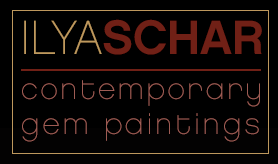
TECHNIQUE
"In the age before industrial manufacture of paints, one either ground one's own pigments or had an apprentice do it. But today [crushing stone is] a gesture of dissent from mass-production, as is painting altogether."
During his early experiments crushing stones, Ilya made an astonishing discovery that expert mineralogists had never before seen. He found that certain gems would change color when ground into powder. Black agate, for example becomes red when ground. Radanite, a rose colored stone, becomes grey when crushed. He was fascinated with the stones' color potential and this discovery gave him the idea to paint using pigment from the stones instead of oil colors. The city of Bremen in Germany even funded a patent for Ilya and published his findings on the color properties of crushed gems.
"Over millions of years these stones have passed through fire, through water, and through pressure. How many millions of years did it take nature to build these colors?"
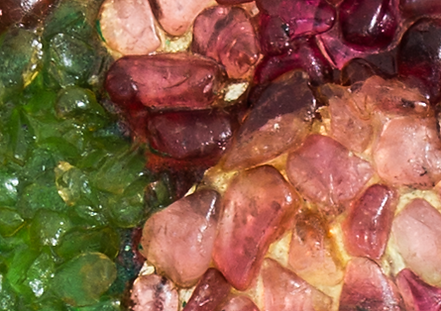
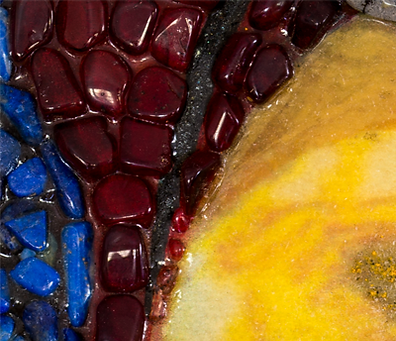
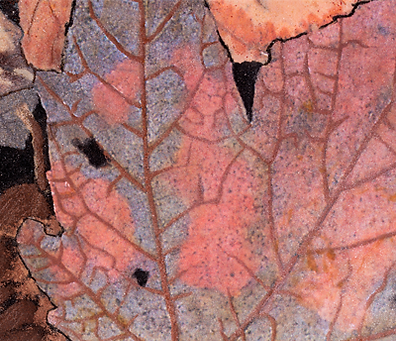
Schar's dazzling compositions bring together gems and minerals collected from all over the world. For example, in "Butterflies 1", he combines adventurine from Sweden, fire opal from mexico, tourmaline from Brazil, emeralds from Colombia, and zinobar from Spain. Other paintings contain hundreds more varieties including diamonds, gold, lapis, amber, garnet, hematite, and rubies. "Each painting has too many stones to record. I would need to have a secretary with me to write it down as I made the picture."
Some have as many as 300 varieties, many of which are mixed into powders. All are held fast with a special adhesive which Schar invented himself. "Diamonds, emeralds, sapphires, and rubies - these are symbols of status, power, and achievement. But what is important for me is the transformation of these symbols into artistic treasures."
The simple beauty of one stone placed next to another is a mainstay of the artist's subject matter. The process of selecting and preparing stones is painstaking and each painting takes months to complete.
In his abstract works, Schar improvisationally applies the gems without making preliminary sketches. But unlike an oil painting that can be endlessly reworked, Schar's materials are unforgiving. Once a stone is affixed, it cannot be removed.

One of his most beautiful abstractions is "innocence, Beneficence of Nature". This piece shimmers with the soft, muted authority of a Chinese landscape painting. Here Schar employs tonal restraint to achive a soft mist-like landscape.
"I am interested in creating a psychological temperature around each painting", said Schar, "using the warmth or coolness of the stones' color."
In this painting, beads of blood red coral flit across the corners and nourish the minty coolness of the enviornment. Bloodstone and chrysophrase suggest cool wet mosses clinging to rocks in the shaddows of twisting vines and overgrown leaves.ou.
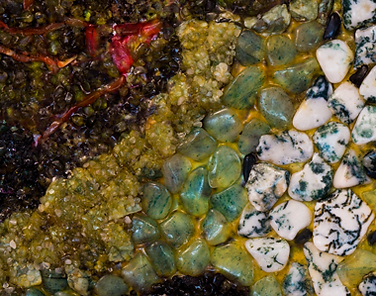
Innocence, beneficence of nature
heliodor, chrysoberyl, chrysoprase, garnet, opal, spinel, tourmaline, peridot, dioptase, emerald, fuchsite, bronzite, bunsenite, coral - 24" x 24" / 2004
Innocence, beneficence of nature (fragment)
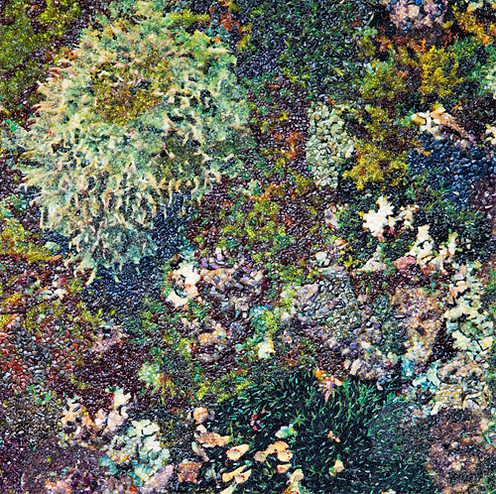
In "Fireworks", Schar's imagination takes flight as he renders the colorful vursts of fire he once witnessed over the sky in Venice. Trumpet-shaped blasts resemble sea anemones with delicate rings of ruby, round their cones. A large curling white explosion in the upper left resembles a clump of tangled seaweed and smaller bursts rendered in delicious green and purple look like the growth of a wil heavenly garden. The painting sizzles with accents of white milk opal and snow quartz.

Fireworks (fragment)
Fireworks
garnet, fuchsite, fluorite, emerald, beryl, ruby, sapphire, heliodor, aquamarine, amethyst, peridot, spinel, opal, ametrine - 24" x 24" / 2004